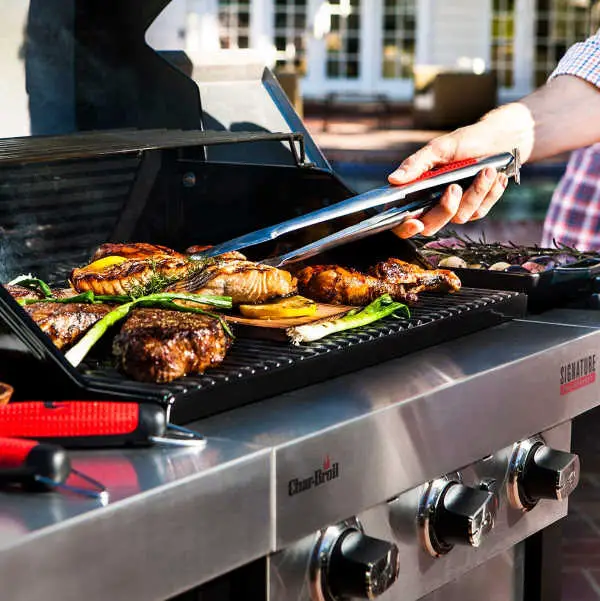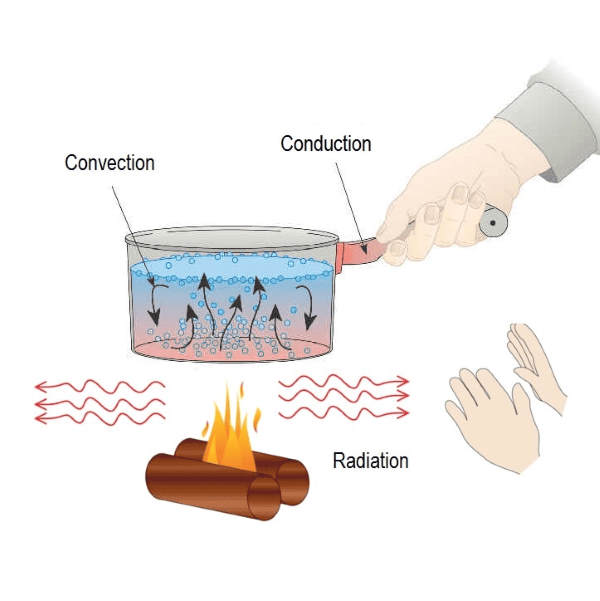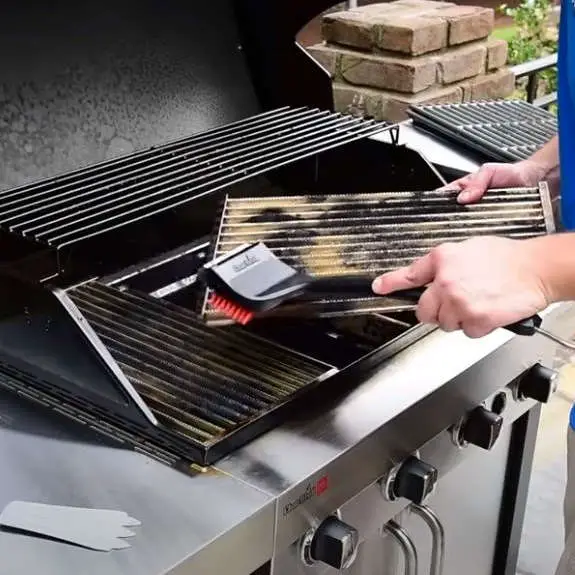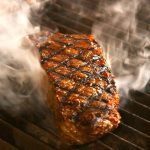
Charcoal grilling is fun but I don’t always have time to set up the charcoal and wait a long time to get hot so that I can finally get cooking. That’s where gas grills come in.
They are much more convenient and get the job done faster.
While searching for the best gas grill for you, I’ve also stumbled upon a similar type of grill, called an infrared.
They are a new-ish type of grill that started growing popular in recent years.
So which one to choose?
In this infrared grill vs gas grill comparison guide, I’ll show you the differences and similarities between these 2 grills.
In the end, you’ll have enough information on which grill to choose.
Before We Get Started
There are a lot of things that differentiate these 2 types of grills but before we delve deep into the differences, it will only be fair that we look at the similarities.
First, the type of fuel that these grills run on is the same.
Gas grills use liquid propane or natural gas as fuel and so do infrared ones. The fuel produces heat that cooks your meals but the method by which the heat is transferred is the main difference.
The varying methods of heat transfer influence the cooking capacity of these two types and this is what I’ll discuss below.
3 Types Of Heat Transfers
What Are the Three Heat Transfers?
The heat reaches your meals by 3 methods which are:

Conduction
Conduction is the transfer of heat through solid surfaces.
Thermal energy from the gas heats up the grates and the food you place on the grill receives this energy as a result of direct contact.
This heat cooks your meals and forms sear marks.
Convection
This method involves the transfer of energy through fluids and/or air.
When you are cooking on your grill, the air just above the grill is heated by the fuel and this heated air is what cooks the food.
Radiation
This is the transfer of heat in the form of electromagnetic waves.
Infrared grills use this form of heat transfer to cook your meals whereby an infrared element is heated by the fuel and this radiates heat within that cooks your food.
What Is the Difference Between an Infrared Gas Grill and a Regular Gas Grill?
With a gas grill, conduction and convection are the primary methods with which heat is transferred to your meals while an infrared grill relies solely on radiation.
The convection method heats the air inside the cooking chamber which then cooks the food but it has a nasty habit of taking away the moisture.
It is for this reason why meals cooked on a gas grill are usually dry and if you like your steaks juicy and succulent then you may be in for a disappointment.
Infrared grills, on the other hand, hardly have any air circulating within them to distribute heat to the meals being prepared and, there is no chance of drying out.
The meals will come out juicy, soft, and full of flavor.
Another thing that differentiates these 2 types is their cooking efficiency.
Infrared grills distribute heat evenly.
Gas grills, however, are limited in this regard.
The conduction and convection methods only work on the part of the food that is in direct contact with the grates. The other parts will have to wait for you to flip them over for them to get properly cooked and this means that you will have to keep turning regularly.

If you’re not paying enough attention, you may overcook and even completely burn your food.
Infrared grills, however, are less mobile than their traditional gas counterparts making them less than ideal for traveling enthusiasts.
You may prefer your meals cooked gently on an infrared grill but if you travel a lot, this is not possible.
Infrared grills are expensive and you should be prepared to pay more for them if you want the best grilled dishes.
Old School and New School
Infrared grills make outdoor bar-b-ques much less of a guessing game.
The days of flame flare-ups and carbonized food have been left behind.
The design of Infrared grills spreads heat from the gas flame across the entire cooking surface rather than having the gas flame emerge from a hole in the burner assembly.
I’ll repeat some things mentioned before because I think they are important and worth mentioning again.
Control Yourself
The beauty of an infrared grill is the level of control the cook has over the heated surface.
Many grills offer heating options for everything from slow-cooked thanksgiving turkey to perfectly-seared rib-eye steaks.
Traditional gas grills require constant attention to prevent flare-ups from scorching the food.
With an Infrared grill, you don’t have to cook in shifts to finish the food; everything can be finished at the same time.
Take Advantage
The features and benefits of Infrared grilling over traditional gas grilling are easily identified:
- Better control over cooking zones: no flame-ups and more precise temperature adjustment
- More efficient cooking: warm-up is faster and cooking requires less time
- Achieve higher temperatures: up to 1,200 degrees Fahrenheit
- More useable cooking area: no cold spots or unheated corners on the grill
A Horse of a Different Color
The one thing I found most challenging about Infrared grills was cooking time.
The temperatures on infrared grills are much higher than traditional gas grills so the food cooks much more quickly.
My old gas grill took 10 minutes to cook a steak but the infrared grill only takes half that time.
Everything cooks faster and more evenly.
My guests think I’m some kind of grilling genius when they see the beautiful results.
Frequently Asked Questions
Is Infrared Grilling Healthier?
Cooking food more evenly and with greater temperature control results in greater health benefits with less waste. Even distribution of heat allows for more thoroughly cooked food that eliminates possible food-borne contaminants or bacteria.
Meats and vegetables retain more moisture when cooked properly, providing additional flavor and nutrients.
Nobody likes unevenly cooked food that is raw in one place and overdone in another.
I like the way food cooks evenly without having to search for the right spot on the grill to get the job done.
Can You Convert a Regular Gas Grill to Infrared?
Gas grills use a different style of pressure regulator and gas dispensing nozzles than an Infrared grill uses.
While it is possible to convert a traditional gas grill to an Infrared grill, it wouldn’t be prudent to try it.
Finding an Infrared section to fit inside a traditional gas grill would be very challenging.
The best thing is to purchase an Infrared grill from the get-go and not worry about becoming a mechanical genius just to make steakhouse sear marks.
Are Infrared Grills Hard to Clean?

The surfaces of Infrared grills are easily removed and cleaned with the added advantage of keeping drips and drops from gathering on the floor of the grill body.
Traditional gas grills can be a challenge to keep clean. The grill itself has to be scrubbed or food will be contaminated with the last bar-b-que’s ingredients.
The body of the grill and the burner assembly should be kept clean as well to prevent fires and flare-ups from occurring.
Should I Get an Infrared Grill?
The average users are better off with a gas grill that can be moved around with ease and are not that expensive.
Take a look at my suggestions.
Get Grilling
Technically speaking, an Infrared grill is a gas grill.
It’s just a different kind that spreads the heat out more efficiently than the old-school gas burners.
This evolution in grilling and bar-b-que cooking takes outdoor food preparation to new heights.
The variety of Infrared grills on the market can make it difficult to choose the right product for yourself.
Infrared grills can be portable (but this is rarely the case), mobile, or built on the family patio deck.
Finding the right grill can take a little time but it is worth the effort.
Outdoor cooking stores, big boxes, and most appliance dealers offer infrared grills for all kinds of uses both residential and commercial.
Don’t be afraid to ask for a demonstration to ensure the Infrared grill works the way you want.
Infrared and gas grills are some of the best choices that you can opt for.
Each of these grills has its advantages and disadvantages and this article on infrared grill vs gas grill highlights them in detail.
What grill did you decide on? A gas grill or an infrared one?





Be the first to comment